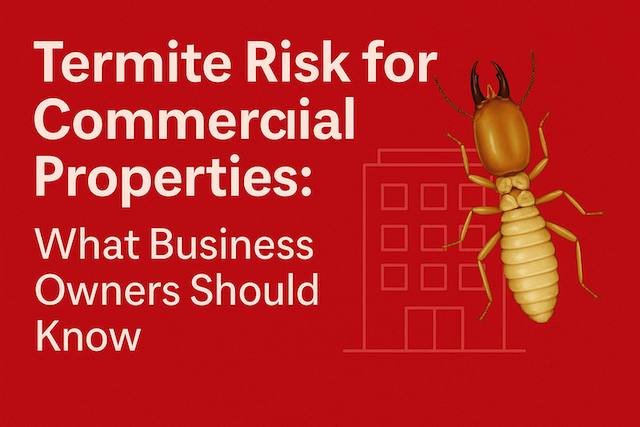
When it comes to running a successful business, factors like marketing, staffing, and customer service often take centre stage. However, there’s one silent threat that many business owners overlook—termites. These small pests can cause massive structural damage to commercial properties if left undetected, resulting in high repair costs and potential disruption to your operations.
Whether you own an office, retail space, warehouse, or F&B outlet, understanding the risks of termite infestations is essential to safeguarding your investment and reputation.
Why Termites Are a Hidden Threat to Commercial Spaces
Unlike residential properties, where termite damage may be noticed during daily use, commercial buildings often go unchecked for longer periods. This gives termites the perfect environment to thrive undetected, especially in hidden areas like false ceilings, under raised floors, or behind drywall.
Key reasons why termites target commercial buildings:
- Abundant cellulose-rich materials: Office furniture, wooden fixtures, cardboard boxes, and shelving units provide ample food sources.
- Less frequent inspections: Busy business schedules often mean building maintenance and pest checks are deprioritised.
- Moisture from HVAC systems: Leaks and humidity from air conditioning systems create the damp environments termites love.
- Older or repurposed buildings: If your commercial space has been renovated multiple times, hidden termite nests may exist in older structures. It’s important to understand common renovation mistakes that can attract termites, so you can avoid repeating them.
Common Signs of Termite Activity in Commercial Properties
Detecting a termite infestation early can save you thousands in repairs. Here are some red flags to watch out for:
- Mud tubes along walls or foundations are typically built by subterranean termites.
- Hollow-sounding wood when tapped, indicating internal damage.
- Discarded wings from termite swarmers near doors, windows, or light fixtures.
- Blistered paint or bubbling surfaces, which may resemble water damage but could be termite-related.
- Rustling noises within walls or partitions during quiet hours.
- Frass (termite droppings) that resemble fine sawdust near skirting boards or wooden fittings.
Consequences of Ignoring Termite Risks
Failing to address a termite infestation in a commercial setting can lead to serious repercussions:
🏗️ Structural Damage
Termites weaken beams, walls, and flooring, compromising the safety and stability of the building.
💸 High Repair Costs
Termites treatment and restoration of damaged areas can be expensive, especially if the infestation has spread to multiple floors or units.
🚫 Business Disruption
Repairs may require partial closures, leading to lost revenue, client dissatisfaction, or even temporary relocation.
⚖️ Regulatory and Safety Violations
For businesses in industries like F&B or healthcare, termite infestations may result in fines, failed inspections, or license suspensions.
Industries at Higher Risk
While all commercial properties are vulnerable, the following sectors tend to be more affected:
- Food and Beverage: Crumbs, moisture, and wooden interiors make restaurants and cafes termite hotspots.
- Warehousing & Logistics: Cardboard, pallets, and packaging materials attract termites.
- Offices: With wooden desks, shelving, and paper storage, termites can thrive unnoticed for long periods.
- Retail Stores: Especially those selling furniture, books, or organic goods.
How to Protect Your Commercial Property from Termites
Prevention is always better than cure. Here’s how business owners can reduce the risk of termite infestations:
✔️ Schedule Regular Inspections
Professional termite inspections at least once a year can detect early signs of activity before visible damage appears.
✔️ Maintain Dry Conditions
Fix plumbing leaks, seal cracks, and ensure proper drainage to avoid excess moisture buildup.
✔️ Use Termite-Resistant Materials
Consider metal or treated wood for fixtures, especially in areas close to soil or moisture.
✔️ Clear Clutter
Store boxes off the floor and away from walls. Avoid piling wooden materials in dark, damp corners.
✔️ Don’t Overlook Soil Treatment
Especially important for landed commercial properties, soil treatment creates a chemical barrier in the ground to block termites from entering your premises.
✔️ Invest in a Commercial Pest Management Plan
Partner with a licensed pest control provider that offers termite monitoring systems, treatment plans, and regular maintenance schedules tailored to your business needs.
Conclusion
Termites may be small, but their impact on commercial properties can be financially devastating and operationally disruptive. As a business owner, staying proactive with regular inspections, preventive maintenance, and professional pest control services is key to protecting your premises, your people, and your profits.
Don’t let termites eat into your business—act early and stay protected.
